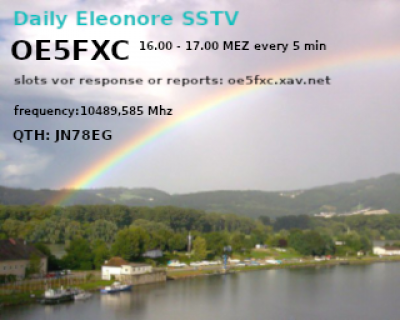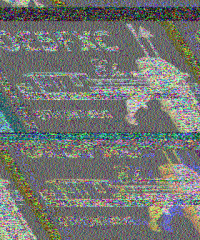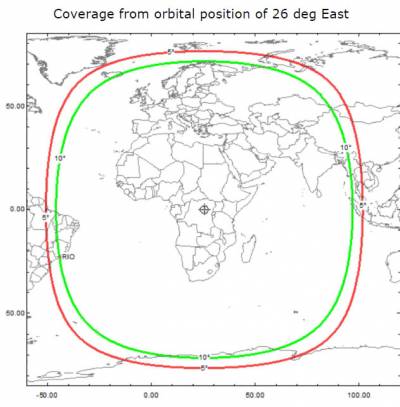Site Tools
Rising Star
The Electromagnetic Space - No Border, No Nation
SSTV image transmissions via the geostationary satellite QO100. SSTV stands for “SlowScanTV”. To save bandwidth, the images are transmitted via an audio signal. The transmission time for one picture takes about 1 - 2 minutes, depending on the compression algorithm.
Hoerbeispiel
mode scotty 2 mode scotty1
From 19.06 - 28.11.2021 we are invited with project at a radio art exhibition at Espace Multimedia Gantner in Belfort(FR).
With this exhibition we start our daily broadcasting. The broadcasts will take place between 16.00 and 17.00 CET every 5 minutes. Between the broadcasts there will always be 3 minutes off air to allow other stations to respond with a picture.
The transmission can be followed acoustically on the WEB-SDR Interface acoustically. A picture interface is still being worked on. Transmission frequency: 10489.586 Mhz
Coverage area of QO100
The rising star as a beacon without borders and nations or can there be a digital intellect behind it?
Why we now work on islands and send signals from there
ABT11 One beacon transmitter of Eleonore
The information society demands more and more logical decisions. In contrast, art offers alternative ways to use emotional information as a decision-making tool. Artists working with technology used to use the working term “media art” for this, in present I can unfortunately only refer to a general art context in dealing with technology and society. The demand for more emotional decisions is also a political challenge, because this opinion also comes from people who reject technological development. But luckily evolution cannot be stopped. In my opinion, the present is characterized by an information technology that is currently developing in a very one-dimensional way. But this is no reason to reject the possibilities of technology. This one-dimensional development can be seen in the lost concept of “net art”. The term “new media art” seems more stable, but I see the reason only in the kinetics or machine art in the time before the Internet. With the digital age, however, the term slid into an insignificant position. But art should reflect technology and the society in full if we don't want to lose our utopias. The difficulty I see in free independent information that freethinkers can no longer easily obtain. There is a lack of technical education. Through the neoliberal age, our information society is increasingly shaped by the rules of the market economy and calculable user profiles. Firewalls on the Internet have long been insufficient to protect us from this. Most of the information that reaches us is manipulated by this filters. Context-free workspaces are becoming smaller and smaller due to the globally networked world, so we looked for secluded places to deliver new inputs. We came to the conclusion that floating islands offer this freedom through their isolation. We have arranged our islands in such a way that we can also invite external artists on a temporary basis. We constructed autonomous living conditions for them, including electricity and drinking water supply. Our island is called Eleonore, and is a converted cargo ship that has been floating on the Danube for 100 years and is currently stationed in Linz.
As a sign of our activity, we have been sending recurring signals from the islands since 2008. Independent of the Internet, these broadcasting signals are meant to stand as beacons for a possible free art in a globally networked world. These beacons could become an important tool to navigate through these turbulent times. The signal could stand for a bulwark in the surf of information. With the Infolab of the Stadtwerkstatt, I have been working since 2012 on an information that is the driving force of our evolution and our modern times.
The electromagnetic space
We live in an electromagnetic space not only since the invention of radio waves. Light is an electromagnetic wave and has always shaped the working space of artists. Our beacons are operated with radio waves which technically can be called beacons. Our beacons are synonymous with free information in a free electromagnetic space. We use this electromagnetic space as our interface in the meanwhile one-dimensional information society to new things on our islands. With it we oppose the global information network with our own transport medium. Via renewable energies we have even minimized our dependencies. The control of all components together with the energy supply becomes a closed cybernetic system that is integrated into the natural energy cycle. Isolation and autonomy, however, also have legal limits for these islands, these are based on the laws and practicable compromises to create something new. Our floating islands are therefore usually still connected to the shore with ropes and bridges in inland waters. If its neccessary in further development, one could also see an autonomous working situation on free-floating islands in international waters.
No Border - No Nation
We use the freedom of electromagnetic waves for our intention. Electromagnetic waves in different frequency ranges behave very differently. In the high frequencies they can be compared to light. The waves can hardly be deflected, but the lower the frequency becomes, the more easily penetrate architectural barriers. The propagation of radio waves cannot be stopped by national borders either. One of the main uses is actually in communications. A beacon transmitter is usually only used for orientation and locating things like radar and GPS. In aviation safety, beacons are often called directional beacons. This beacons are highly directional radio waves that are emitted in a circular pattern, like a lighthouse. Aircraft, for example, can use this invisible “beam” to orient themselves in poor visibility conditions. Our beacon transmitter in the shortwave range could also be called an undirected beacon.
We operate two beacon transmitters on the Eleonore. One in the shortwave range since 2008 and one via the geostationary satellite Es'hail. Es'hail means rising star in Arabic. Both transmitters operate in complete different frequency ranges. In both frequency ranges the electromagnetic wave is invisible and has a direct connection with our haptic world only via the antenna.
Our shortwave frequency is 7 Mhz. This means 7 million vibrations per second they penetrate buildings easily and are almost unstoppable. They even “bend” more easily and do not end at national borders, thus freeing our interface from architecture and area claims.The length of the antenna is always equal to or a multiple of the wavelength of the oscillation and in our case is only 20m long wire.
Besides the shortwave range we also use satellite radio since 2020 to make our transmissions. Amateur radio has a strict set of rules regarding (commercial) use and offers us a great opportunity to take a closer look at our information society. Through this amateur radio satellite we can reach a large area. We reach an area from South America to India and from Spitzbergen to Antarctica. A satellite uses very high frequencies and the waves behave like light.The antenna is only a few mm long and the frequencies hardly penetrate buildings and for reception you need a clear view towards the satellite. For this reason, the geostationary satellite is located at an altitude of about 36,000 km. This is about one tenth of the distance to the moon. It flies as fast as the earth rotates and seems to stand still which makes the alignment of the antenna easier. It “floats” apparently quietly in a nationally free space. Space is regulated but belongs to no one.
The information that is sent out is representative of the whole cybernetic and social component of our island. The information that is sent out positions us over a free electromagnetic space in a society that is characterized by only one information medium. The signals that are sent out have no system-relevant or political content. The content of the image has also nothing to do with the artistic debate, the reason is anly a free communication to people who themselves control their technology. The sending itself is therefore the artistic work, with the interface to the human being. The information we send is only the time of the transmission, the coordinates, Internet address, power and the call sign of the station. We hope for many reception reports from all over the world, because through them we can control the range of our transmissions.
The reports from satellite radio can be viewed on our website http://oe5fxc.xav.net. In the shortwave range it is the site https://wsprnet.org.
 Except where otherwise noted, content on this wiki is licensed under the following license: CC Attribution-Noncommercial-Share Alike 4.0 International
Except where otherwise noted, content on this wiki is licensed under the following license: CC Attribution-Noncommercial-Share Alike 4.0 International

